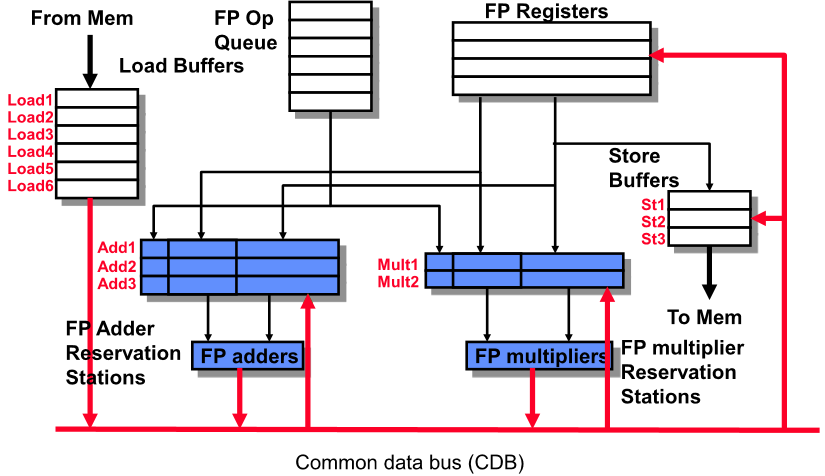Tomasulo Alogorithm vs Scoreboard
dynamic algorithm의 또 다른 방법인 Tomasulo(High Performance without special compiler)
Control & Buffers 가 분산되어 있음 vs 집중화됨
- FU Buffers 는 reservation stations이라고 부름
Function Units과 reservation stations은 Common Data Bus로 연결되어 있음(Broadcast)
Load, Store 도 RS로 간주해서 생각
Tomasulo Organization
Reservation Station Components
Reservation station:
- op: unit을 수행할 operation
- Vj, Vk: Source operands의 값
- Qj, Qk: source registers를 생산하는 Reservation station
- Busy: FU is busy
Register result status: 어떤 functional unit이 각각의 register 에 write할 것인지를 가르킴
Three Stages of Tomasulo Algorithm
Issue: FP Op Queue에서 instruction 을 가져옴
reservation station이 free 하여 structural hazard가 없을 경우 issues 하고 operands를 보냄
Execution: operands를 가지고 연산 실행
operands 가 두 개다 ready 되면 execute
만일 ready 되어 있지 않다면 Common Data Bus에서 결과를 기다림
Write result: 실행 완료
Common Data Bus에 Write하여 기다리는 units에게 전달
Normal data bus : 특정 destination으로 가는 것(go to bus)
Common data bus : data + source i.d(come from bus)
Tomasulo vs Scoreboard
Piplelined Functional Units vs Multiple Functional Units
windows size: 14 instructions vs 5 instructions
No issue on structural hazard same
WAR: renaming avoids vs stall completion
WAW: renaming avoids vs stall completion
Broadcast results from FU vs Write/read registers
Control: reservation stations vs central scoreboard
Tomasulo Drawbacks
- 복잡함
- 여러개가 동시에 stores 시 high speed CDB 필요
- 여러개의 Common Data Bus를 쓰면 더 많은 Funtional Unit과 동시에 처리가능하지만 cost 와 복잡도가 증가함
Tomasulo Summary
Reservations stations 을 통해 dynamic renaming 을 수행(WAR, WAW 해저드 제거, HW적으로 loop unrolling 수행하는 것 처럼 보임)
basic blocks에 제한되어 있지 않음
Dynamic Scheduling, Register renaming, Load/Store disambiguation 에 기여함
Register bottleneck 제거
